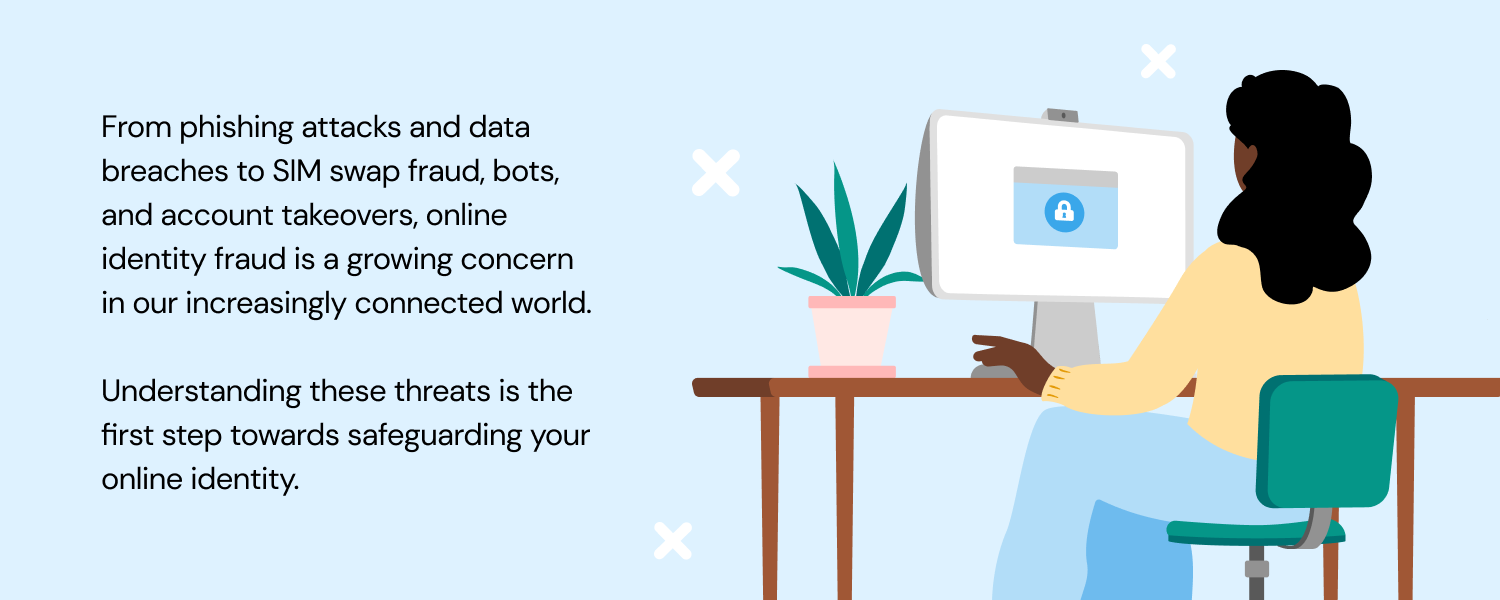In the digital age, our identities extend far beyond our physical selves. They encompass our online personas, shaped by our activities and interactions on the internet. However, the rise of online identity fraud has cast a shadow over the security of our online identities. This article will delve into the top five online identity fraud trends, providing an in-depth understanding of each problem, its implications and solution.
The 5 types of online identity fraud you need to know
1. Phishing attacks
Phishing attacks, sometimes referred to as phishing emails, are everywhere. These online identity fraud attacks cleverly disguise themselves as legitimate communications, tricking users into revealing sensitive personal information. What’s worse is that these attacks are becoming more sophisticated, making it harder for individuals to distinguish between genuine and fraudulent communications.
Phishing attacks exploit human psychology, capitalizing on our tendency to trust familiar brands and our desire for convenience. Mimicking the look and feel of emails or websites from reputable companies, they lure users into a false sense of security. Once users unwittingly enter their personal information, fraudsters can use that data for a variety of malicious purposes, from unauthorized transactions to identity theft.
As phishing attacks become more subtle and intricate, they are becoming harder to detect. They use advanced techniques such as cloaking, where the fraudulent website or email appears different depending on who is viewing it, and fast flux, where the fraudsters rapidly change the IP addresses associated with their phishing sites to evade detection.
2. Data breaches
Data breaches pose a significant threat to online identity security. These incidents occur when unauthorized individuals gain access to confidential data, often leading to the exposure of sensitive personal information. The consequences of data breaches can be severe, resulting in financial losses, reputational damage, and a breach of trust between businesses and their customers.
Data breaches can occur due to a variety of reasons, including weak passwords, outdated security systems, and human error. They highlight the importance of robust data security measures, including strong encryption, regular security audits, and employee training on data protection best practices.
In addition to the immediate financial impact, data breaches can have long-term effects, potentially leading to legal consequences. In some cases, the data stolen in a breach can be used to commit further crimes, creating a ripple effect of online identity fraud.
3. SIM swap fraud
SIM swap fraud is a type of identity theft has the potential to compromise a wide range of personal information and services. In a SIM swap fraud, a bad actor tricks a mobile carrier into transferring a victim's phone number to a new SIM card.
Once the fraudster has control of the phone number, they can bypass security measures such as two-factor authentication, gaining access to the victim's email, bank accounts, and other sensitive accounts. This type of fraud highlights the need for additional security measures beyond just mobile-phone-based authentication.
SIM swap fraud is particularly insidious because it can be difficult to detect until it's too late. The victim may not realize what's happening until they notice that their phone has lost service, or they start seeing unauthorized activity on their accounts. By the time they realize they've been targeted, the fraudster may have already caused significant damage.
4. Bots
Bots, automated software applications that perform tasks on the internet, can pose a significant problem for businesses. While many bots are beneficial, others have been used for malicious activities such as spamming, scraping websites, and carrying out distributed denial-of-service (DDoS) attacks.
In the context of online identity fraud, bots can be used to create fake accounts, skew analytics, and perform fraudulent transactions. This highlights the importance of robust bot detection and mitigation strategies, such as CAPTCHA tests, user behavior analysis, and IP reputation checks.
Bots can be particularly problematic because they can operate at scale, carrying out many fraudulent activities in a short amount of time. They can also be difficult to detect, as they often mimic human behavior to evade detection systems. This makes them a significant threat to online identity security.
5. Account takeovers
Account takeovers occur when a fraudster gains access to a user's account and takes control. This can happen through various methods, including phishing attacks, data breaches, and brute force attacks. Once the fraudster has control of the account, they can carry out fraudulent transactions, send spam, and even lock the legitimate user out of their account.
Account takeovers underscore the need for strong account security measures, such as complex passwords, two-factor authentication, and account activity monitoring. They also highlight the importance of user education in recognizing and responding to suspicious account activity.
Account takeovers can have serious consequences, both for the individual whose account has been taken over and for others who interact with the account. The fraudster can use the account to send spam or malicious links, tricking others into falling for similar scams or revealing their personal information. They can also use the account to carry out fraudulent transactions, potentially leading to financial losses for the individual and the business.

Sinch's Unified Verification
While the problems of online identity fraud are complex and multifaceted, with many of the issues stemming from weak identity and authentication, solutions are available that can help businesses protect their customers and themselves. One such solution is Sinch's Unified Verification API, an online identity fraud prevention solution. Although consumer applications often rely on limited SMS 2FA, there are now more consumer 2FA solutions available that can further enhance security.
Sinch's Unified Verification API is an all-in-one solution that removes complexity from the equation. It provides an integrated verification solution that orchestrates auto-selection of verification methods and fallbacks with global coverage and high security. Driven by data intelligence, Sinch optimizes verification method selection, drives down costs, and helps customers to reduce churn, increase revenue, and increase customer satisfaction.
Are you ready to take a stand against online identity fraud? With our comprehensive solution, you can protect your business and your customers from the ever-evolving threats of online identity fraud. Don't wait for a breach to happen. Take proactive steps today to secure your online identities. Learn more about Sinch Verification or contact one of our experts for a personalized consultation.



